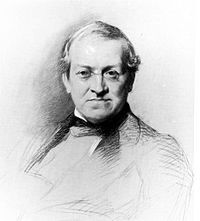
Photo from wikipedia
Abstract Present framework addresses the nanofluid flow which occurs over a thin needle moving axially with uniform velocity in the same direction as that of the external free stream. The… Click to show full abstract
Abstract Present framework addresses the nanofluid flow which occurs over a thin needle moving axially with uniform velocity in the same direction as that of the external free stream. The needle is a thin paraboloid of revolution which has diameter of the same order as that of the boundary layer formed around it. Problem formulation is made through Buongiorno's model which involves the aspects of two velocity slip mechanisms namely Brownian diffusion and thermophoresis. Appropriate transformations are utilized to convert the governing system of partial differential equations (PDEs) into ordinary ones. An easy to implement shooting approach is opted to present numerical approximations of the problem. For validation purpose, the solutions are also computed by boundary value problem solver (bvp4c) of MATLAB. The solutions predict that the flow fields strongly depend on the size and shape of the needle. Flow problem involves a parameter λ which enables us to compare the needle velocity with the free stream velocity. Skin friction coefficient and heat transfer rate at the needle surface are also scrutinized in detail. Drag reduction, which is important in various applications, is anticipated by enhancing the free stream velocity. However, needle velocity contributes to a growth in wall shear stress. Interestingly, Brownian diffusion does not alter the heat transfer rate at the needle surface. Maximum heat transfer rate is accomplished for the situation in which thermophoretic effect is absent.
Journal Title: Chinese Journal of Physics
Year Published: 2017
Link to full text (if available)
Share on Social Media: Sign Up to like & get
recommendations!